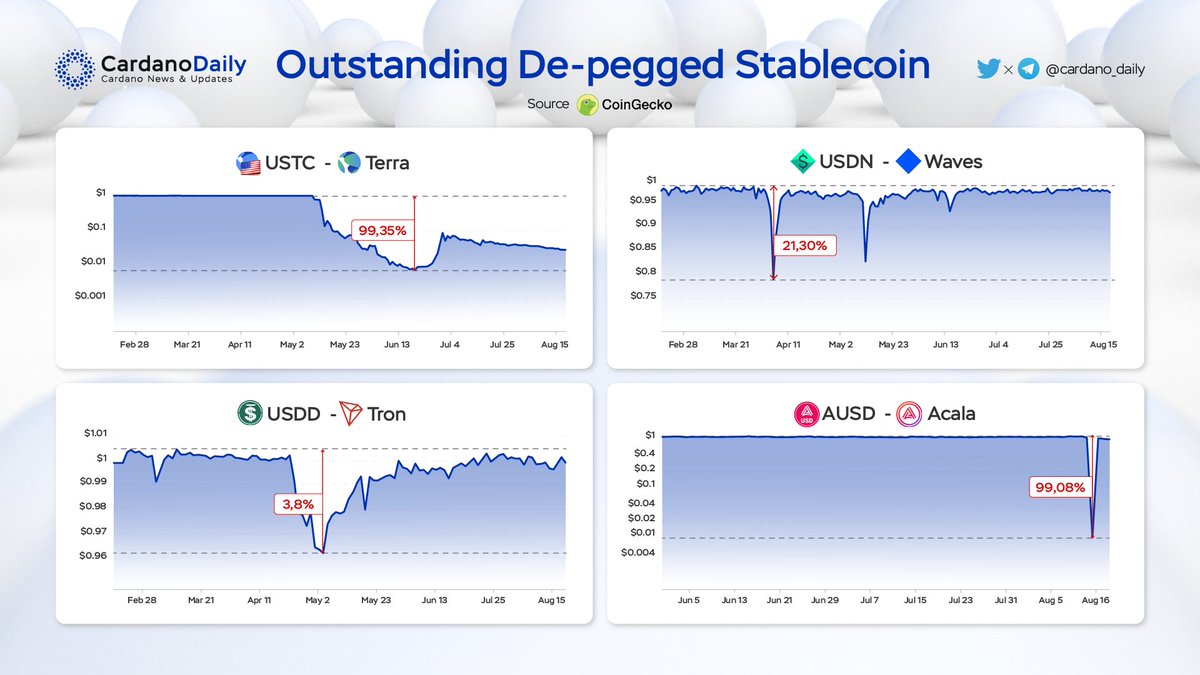
OUTSTANDING DE-PEGGED STABLECOIN
Our @Cardano ecosystem is also having our own stablecoin, known as $DJED - @DjedStablecoin. However, before deep diving into the $DJED, let’s take a first look at other stablecoins on the crypto market to have a lesson.
#stablecoin #depeg
Our @Cardano ecosystem is also having our own stablecoin, known as $DJED - @DjedStablecoin. However, before deep diving into the $DJED, let’s take a first look at other stablecoins on the crypto market to have a lesson.
#stablecoin #depeg

@Cardano @DjedStablecoin 1. Well, if you guys are involved in the crypto market lately, I am sure you guys shall be familiar with $UST ($USTC) of the @terra_money ecosystem. $UST is the algo-stablecoin, which has been guaranteed by $LUNA ($LUNC).
#stablecoin #depeg
#stablecoin #depeg
@Cardano @DjedStablecoin @terra_money 2. In May, we don't know yet if this is a purposely attack or anything else behind this mess, $UST had lost its peg and completely went to nearly 0. Since then, $UST is just like a meme token for traders to speculate, not remaining its role as a “stablecoin”
#stablecoin #depeg
#stablecoin #depeg
@Cardano @DjedStablecoin @terra_money 3. The 2nd is $USDN of @wavesprotocol. After a lot of FUD related to Alameda Research, $USDN lost its peg, reaching a low around 0.8 and creating a 21,3% drawdown. However, $USDN has found its $1 peg today - but the $WAVES price is still 90% down from its ATH
#stablecoin #depeg
#stablecoin #depeg
@Cardano @DjedStablecoin @terra_money @wavesprotocol 4. The 3rd is $USDD of @trondao. As mentioned in their whitepaper, this stablecoin has the collateral ratio up to 200% - enough to ensure $USDD at the rate of $2.
The de-pegged of $USDD only occurred at the same time with $UST, when all algo-stablecoin at that time got attacked.
The de-pegged of $USDD only occurred at the same time with $UST, when all algo-stablecoin at that time got attacked.
@Cardano @DjedStablecoin @terra_money @wavesprotocol @trondao 5. The 4th and also the latest depeg in the crypto market is $AUSD of @AcalaNetwork. A hacker has utilized the faults of the project, exploiting the tokens and draining funds from Acala’s iBTC/aUSD liquidity pool.
#stablecoin #depeg
#stablecoin #depeg
@Cardano @DjedStablecoin @terra_money @wavesprotocol @trondao @AcalaNetwork 6. However, aUSD came close to regaining its peg to the U.S. dollar after the platform burned over 1.2 billion aUSD tokens that were minted by exploiters.
#stablecoin #depeg
#stablecoin #depeg
@Cardano @DjedStablecoin @terra_money @wavesprotocol @trondao @AcalaNetwork 7. So, do you take away any from these above?
- Algo-stable is not a perfect mechanism, or else it remain a deadly point - the death spiral.
- Even collateral-guaranteed stablecoin is also being attacked by the fault of the system.
#stablecoin #depeg
- Algo-stable is not a perfect mechanism, or else it remain a deadly point - the death spiral.
- Even collateral-guaranteed stablecoin is also being attacked by the fault of the system.
#stablecoin #depeg
@Cardano @DjedStablecoin @terra_money @wavesprotocol @trondao @AcalaNetwork 8. Let’s wait to discuss more about $DJED - the stablecoin of our ecosystem.
#stablecoin #depeg
#stablecoin #depeg
• • •
Missing some Tweet in this thread? You can try to
force a refresh







